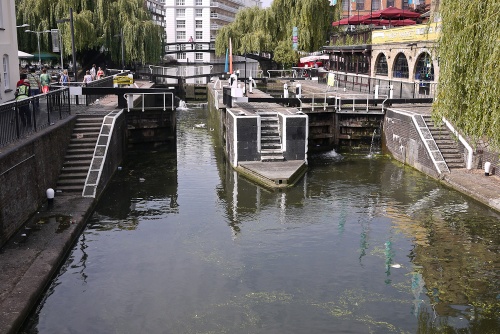Karen and I have just returned from a short visit to Paris (France, not Texas). I have been there twice before, but until Karen told me there was a canal that ran through the middle of the city, I was oblivious to its existence. Thanks to the internet we were able to rent an apartment just a couple of blocks from the Canal Saint-Martin.

Our plan was to hang out in the neighborhood and pretend we lived there. We would sit at cafes and drink coffee, and we would stroll along the canal, as these Parisians are doing:

The canal was constructed between 1802 and 1825, by order of Napoleon I, to bring fresh water to Paris and for the transport of goods. It runs 4.5 kilometers from the Bassin de la Villette to the Port de l’Arsenal just off the Seine River. Nine locks raise or lower boats a total of 27 meters.

This barge in the Bassin de la Villette flew the Dutch flag:

There are three movable bridges that cross the canal. Two are swing bridges, and one is a vertical lift bridge. This is part of the lifting mechanism:

Two companies run tours along the canal, and there was no way we were not going to take a canal-boat trip. Here is one of the boats that Paris Canal operates. This is the company we used.

This bridge is confused. It says, “Rise up!” but it doesn’t rise.

It swings!


Here is a boat from the other company, Canauxrama, with just a few tourists. (It was a cold, rainy day.)

As soon as the gate goes up, the waiting traffic takes off:

The canal is still used for commercial traffic. Here a barge passes through the Parc de la Villette (the starting point for our boat trip) and approaches the junction with the Canal Saint-Denis:

This sign is at the first lock on the Canal Saint-Martin: 4.5 kilometers to the Seine.

Despite the weather, Karen was very happy to be descending the canal:

Inside the first lock:

Eight of the nine locks on the canal are double locks where you pass directly from one lock into the next:

Just below the Bassin de la Villette the canal passes through a short tunnel. The “1825” carved into the rock is the year the canal opened:


Here we both are, happy to be on a boat, in a lock, in Paris:

About half of the canal runs through a tunnel. Only this first section has artificial lighting. The rest of the tunnel is dark, except for openings every block or so to allow light and air in.

At the end of the two-kilometer-long tunnel we exited into the Port de l’Arsenal, just below the Bastille:

This marina is home to a variety of boats, one much more colorful than the others:

And there’s this Dutch canal boat:

At the end of the canal, two means of transportation cross. The Seine is visible just beyond the last lock:

Read Full Post »











































